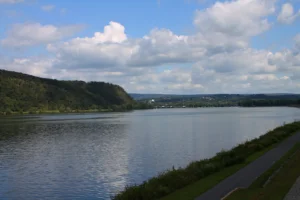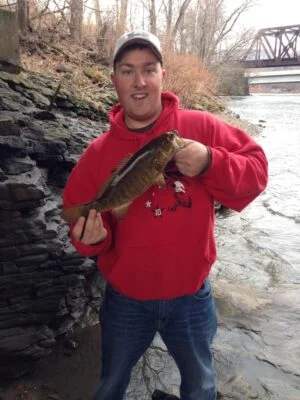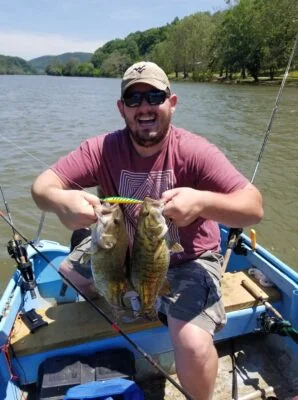
So you’re ready to tackle the longest river on the East Coast? With over 400 miles of fishable water, “The Susky” is a goldmine for smallmouth bass anglers all over the country. In this guide, I’m providing you with a local take on this fantastic river with some commentary from a few “wise men” as well.
Where to Fish the Susquehanna River
The first thing many unfamiliar travelers notice about the Susky is how long it is. It has hundreds of miles of fishable water, with most of the riverbanks running through Pennsylvania, accessible by shore or boat.
A big challenge you face is knowing where to tackle it and how to cover enough water to be able to find the honey hole.
The best way to make this determination is by choosing the species you want to catch. For example, the West Branch of the Susquehanna begins right around Huntington in Central PA, and it runs East until it runs into the Lower Susquehanna around Sunbury in Northumberland County.
This section of the river is the best for trout fishing, and it houses one of the strongest populations in the entire state.
A quick trip East towards the Middle Susquehanna brings upon some serious smallmouth bass fishing, and that’s what we’re talking about today.
The Middle Susquehanna begins around Great Bend, which is right at the PA/NY border. The river runs through Bradford, Wyoming, Luzerne, Columbia, and Northumberland Counties. These are your smallmouth bass fishing destinations. Let’s narrow it down a little more.
Luzerne County
These are my waters, I grew up fishing here almost weekly with my father, and he can tell you almost every ideal location to fish along this section of the river.
One of our most frequent areas is called Canal Park in West Nanticoke. The river narrows up here quite a bit, increasing the current, so it’s not always the easiest to fish, but there is an abundance of smallmouth bass here.
If you’re here in the dead of summer when the water levels are low, I recommend going with a lipped crankbait. Toss it around the bank and retrieve it quickly because the bass will have high visibility during dry periods when the water is really clear.
Wyoming County
Whites Ferry was another frequented spot by myself, my father, and all of my friends. You have to travel a little bit Northwest, just South of Tunkhannock. The river runs North and South here, and if you drift South a couple of thousand feet, you’ll run into a few splits in the river.
There are about three islands until the river widens dramatically and levels off about 2-3 miles in.
These splits in the river are where you’ll clean up on smallmouth if you know what you’re doing. If you’re fishing a warm summer morning, get a ¼ ounce buzzbait and hit all the grass beds along the bank of those islands, cutting the river in half.
If the weather is more moderate, you’ll need something with a slower and less aggressive presentation. A Rapala usually does the trick most of the year.
While you don’t have to hit these two locations, I highly recommend them. Keep in mind that you can fish anywhere between Bradford and Columbia County and catch smallmouth bass.
How to Fish the Susquehanna River [By Season]
Now that we narrowed the river down to a few choice locations let’s discuss what lures to use and how to present them based on the time of year. Pennsylvania has all four seasons, but us locals like to refer to them as:
Winter, Still Winter, Summer, and Winter
So, if you’re fishing the Northeast PA waters, you need to understand that water clarity is at its lowest during the Spring and Fall months when rain is at its highest.
During these times, the river is also flowing much faster due to higher levels, which makes it more challenging to fish.
If you’re planning a trip around fishing the Susquehanna, I recommend going between the months of June-October. The water will be at its warmest, the clarity will be good, and you’ll have plenty of hours of daylight, which extends the fishing day.
Late Spring/Early Summer
This is the post-spawn season, so you’ll want to fish the banks hard. Keep in mind that smallmouth bass are more aggressive at this time, and they’re most aggressive towards topwater baits hovering over their heads.
If you can fish a topwater floating minnow or something similar to that, you should be golden. Look for fallen trees, logs, and heavy vegetation along the shore, and you’ll likely find spawning areas.
Mid-Summer/Early Fall
This is the “hot” season in Northeast PA, where average daily highs are around 80-85 and the lows are somewhere around 60-70. At this time, the water temperature stays pretty warm, which will increase the smallmouth’s willingness to chase your lure. They’re also targeting topwaters pretty heavy at this time.
I’d go with a topwater popper in the heat of summer. Something that makes a loud, chugging noise. Rebel and Rapala make plenty of these that will do just fine. I’d try drifting it through areas of shade from low-hanging trees.
That said, if you’re fishing around September-October and the temperature is starting to dip, you’ll want to go with a hair jig. These are great when water temps are a little cooler than usual, and the levels are high. That opens up some deep pockets in the river where you can get some relief from the current. Crawl the jig slowly along the bottom here in the rocky pools, and you’ll find some smallies, guaranteed.
Local Angler Tips and Tricks

This wouldn’t be a complete guide if all I did was spew my opinions at you, right? I had to get some of my friends and fellow anglers to chime in here to see what they had to say about fishing the Susky.
My friend, since we were in diapers, Adam Misura, talked about his favorite spot on the river and some lures he likes to use. He also had a little criticism about my recommendations:
“The Route 6 Bridge Access Ramp is my favorite place to launch the boat. It’s near the Towanda Riverside Park. The river is really slow here, and there are a lot of pockets where it’s completely still. You want to fish these pools for smallmouth bass. I don’t believe in taking a bunch of lures in the boat with me because I rely entirely on two. You’ll want a whopper plopper with a stop n’ go presentation. If you don’t have one of those, a simple finesse jig will work.”

I’ll agree with Adam on a few things, especially the whopper plopper. Those lures are dynamite in the river because the presentation is really natural if you drift them. They create a lot of noise too, so they work well even when visibility is low.
An old work buddy of mine [Marcus Waleva] who was a frequent shoreline angler on the Susquehanna had some things to say as well. He offers a unique perspective because he doesn’t fish by boat.
“Apple Tree Road along the Sullivan Trail in Exeter is where you want to be. It’s really open, there’s very little vegetation, and you can walk up and down the entire shore in boots. From here, all the way down to Pittston, is completely open water. I like to use crankbaits because there are no weeds, and you need to take advantage of the rocks if you’re going to catch anything.”
This area was another frequent spot for my dad and me. One time, we sunk into the mud on the shoreline up to our waists, trying to walk up and down the shore. If you’re fishing in the Spring, be careful.
Regardless of where you hit the Middle Susquehanna, you’re sure to find abundant smallmouth bass fishing. Good luck out there!
Bio: Coty is a third-generation angler mastering the waters of Northeastern Pennsylvania. He specializes in bass fishing and has contributed to many of the internet’s most popular fishing blogs. When he’s not fishing or writing about fishing, you can find him tossing the ball around with his son.

